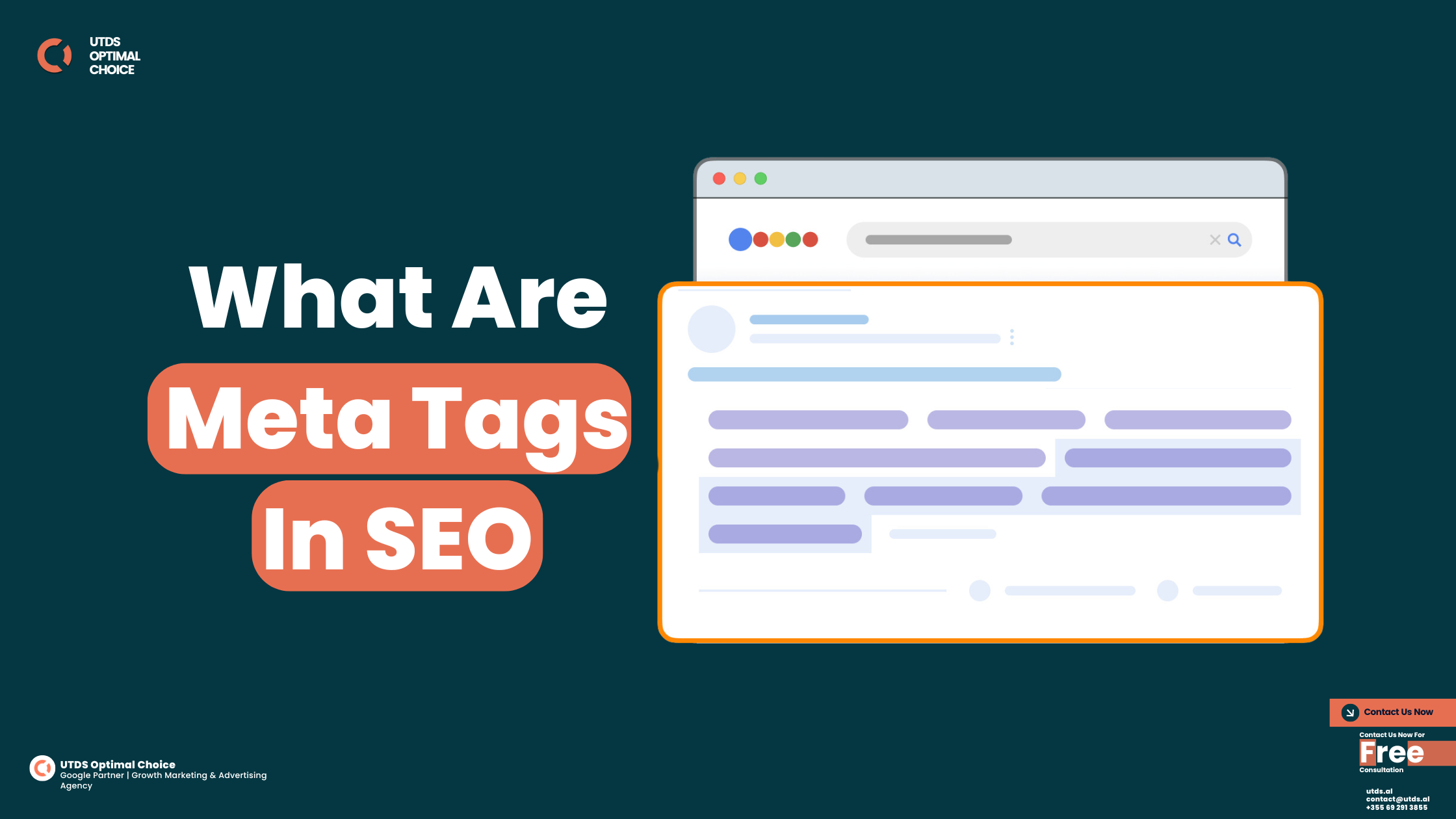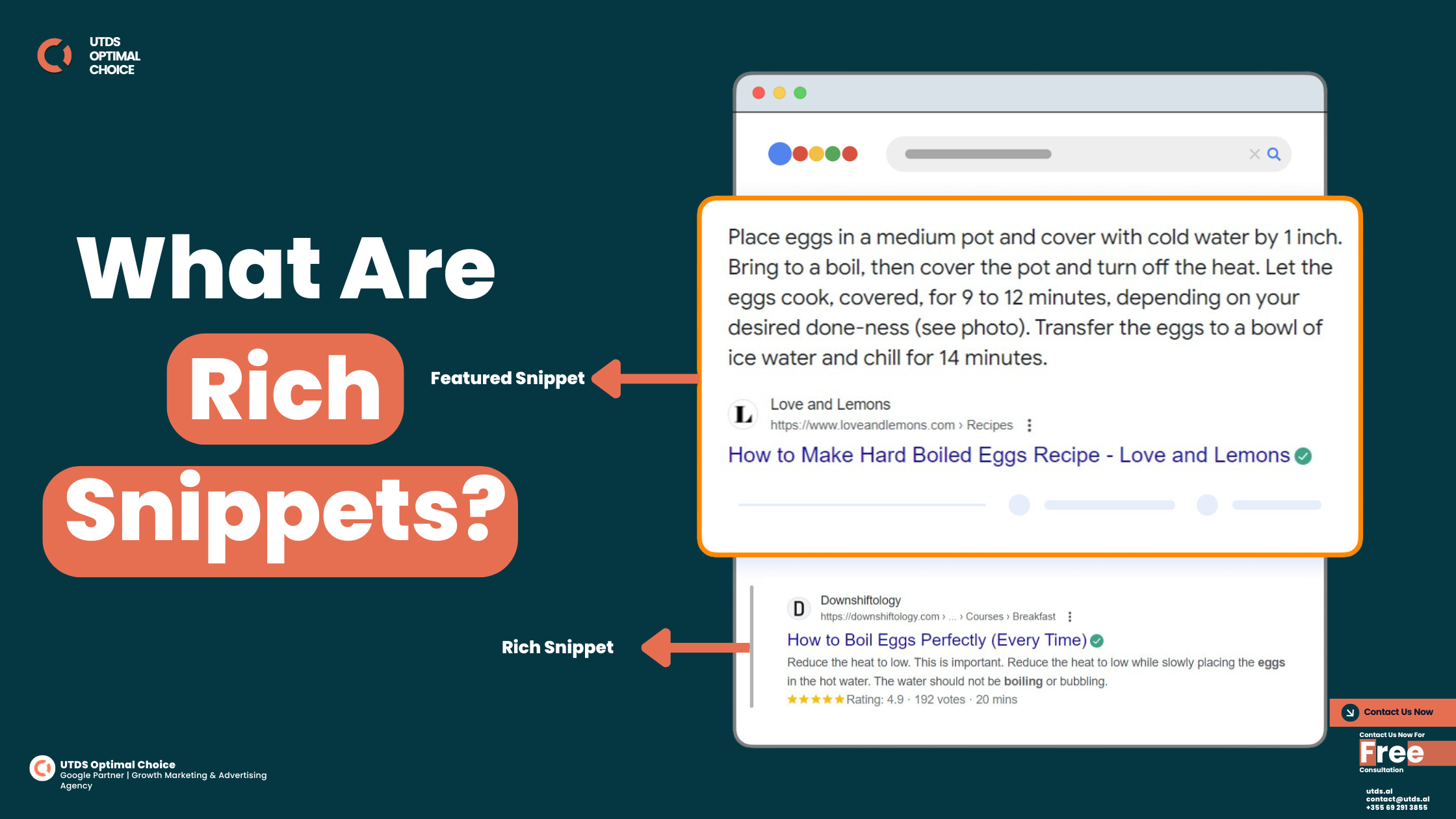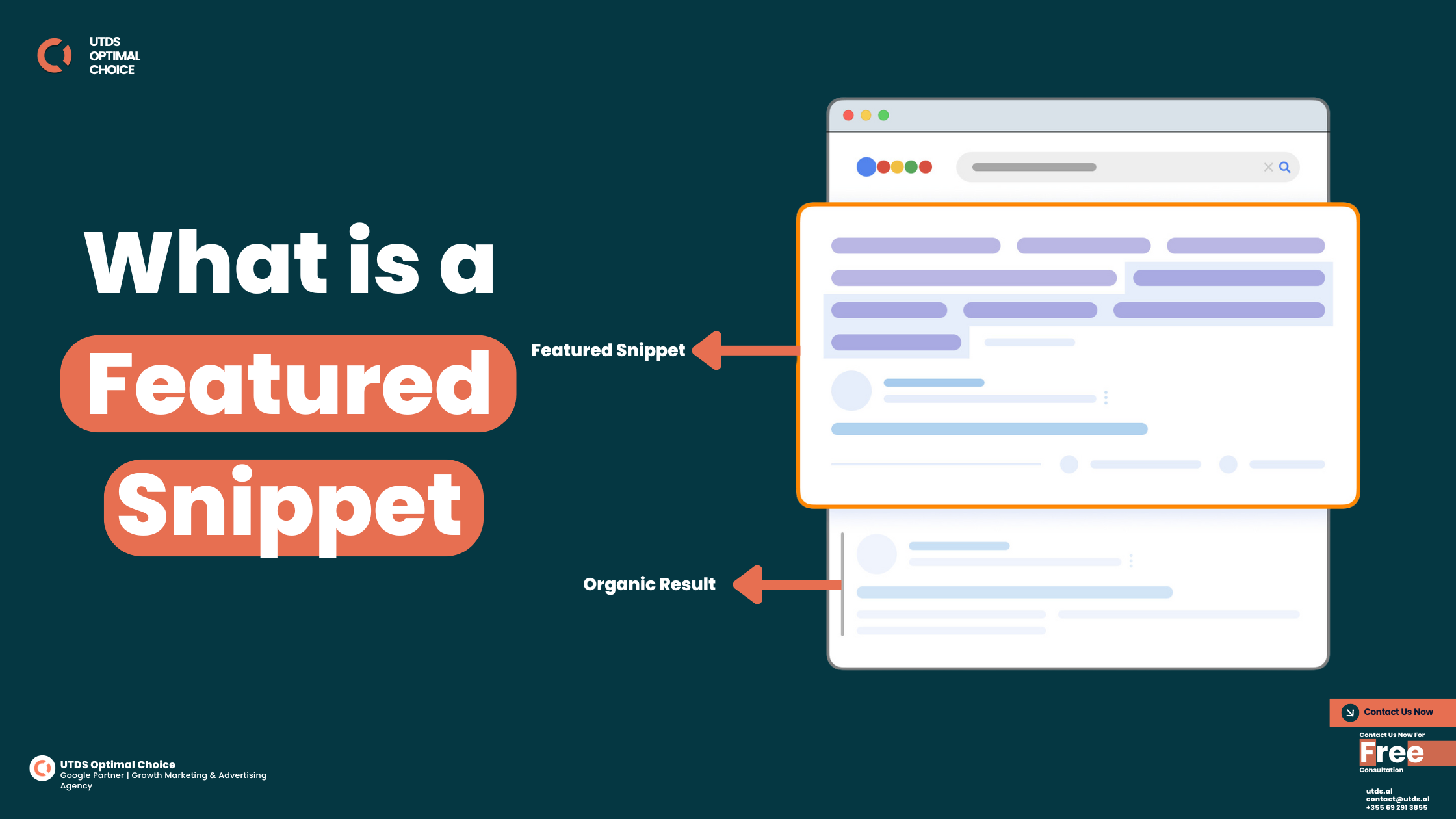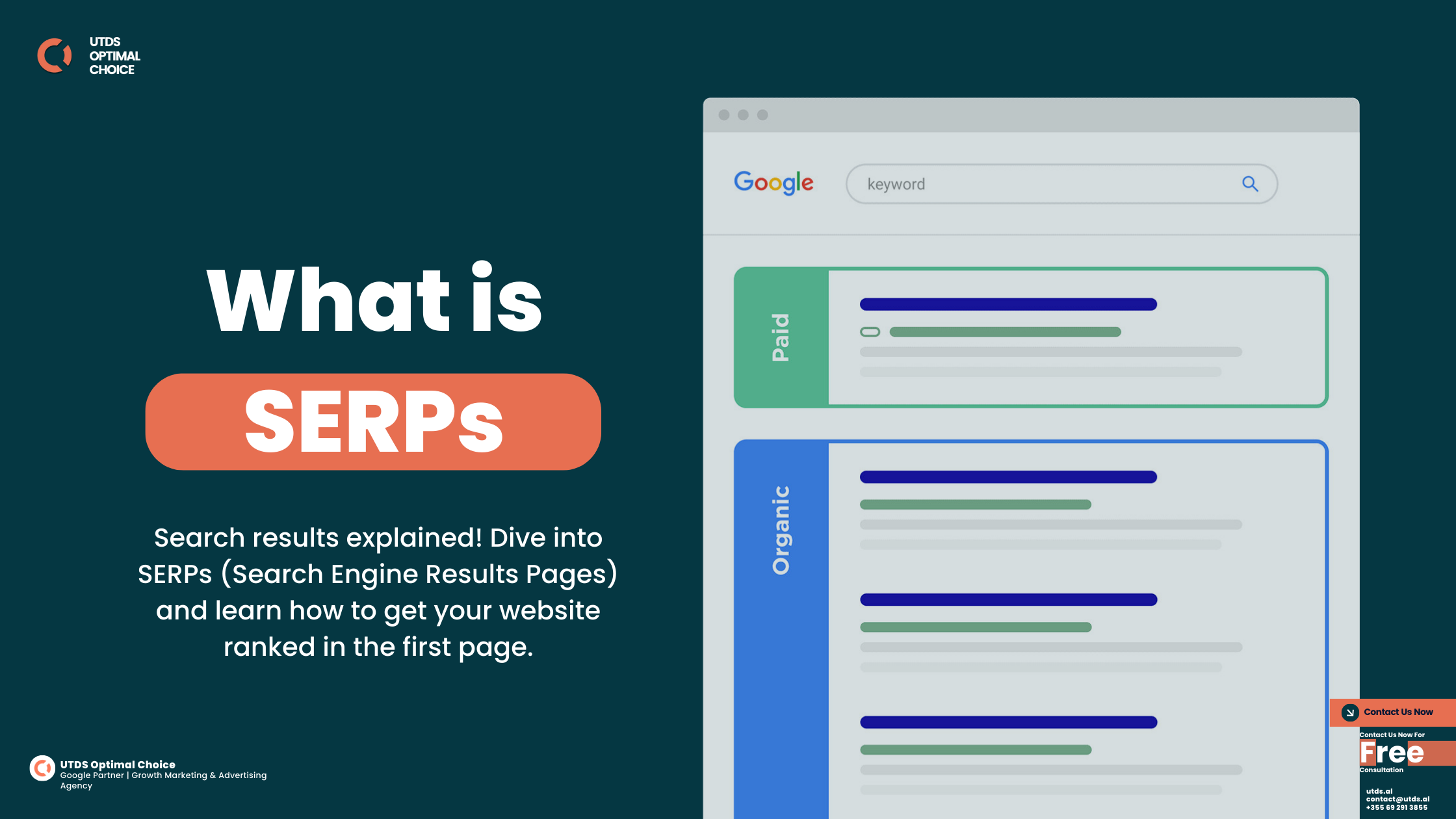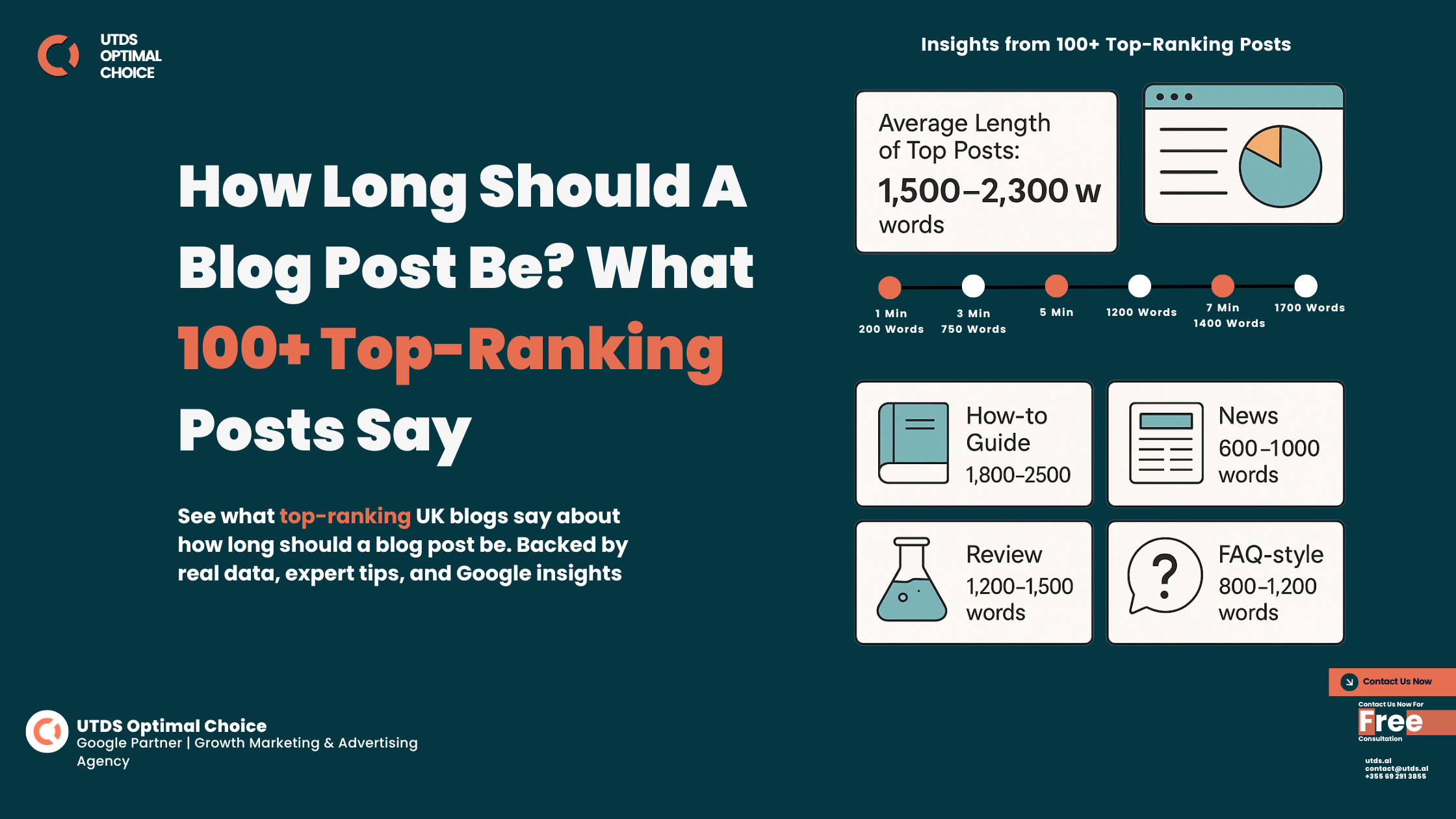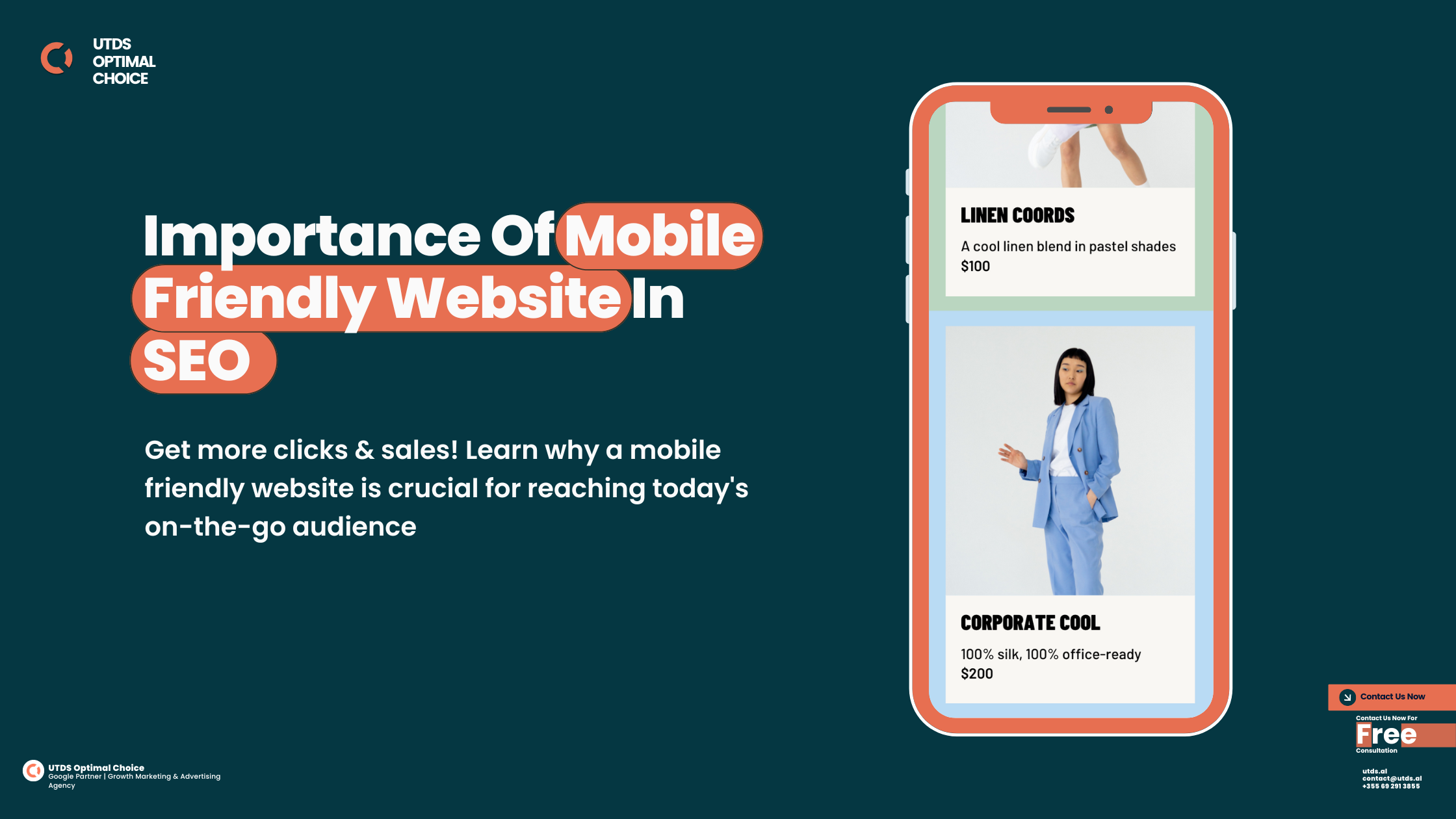Keyword research is the backbone of any successful SEO strategy. It involves the process of identifying the specific search terms and keywords that users enter into search engines like Google to find relevant information. By understanding these keywords, businesses can craft content that not only meets the needs of their audience but also drives significant organic traffic and improves search engine rankings.
Moreover, it’s important to know, keyword research plays an important role in promoting your local businesses among local audience. Effective keyword research is not just about finding popular keywords; it’s about understanding the search intent behind those searches and using this insight to optimise your content strategically. Whether you’re aiming to attract more visitors to your website or convert leads into customers, mastering SEO keyword research is essential.
In this guide, we will explore
- the importance of keyword research,
- the key elements involved in the keyword research process, and
- advanced techniques that can help you stay ahead of your competitors.
By the end of this guide, you’ll have the knowledge and tools to conduct effective keyword research and use it to enhance your content strategy and achieve your business goals.
Keyword research is the foundation of a successful SEO strategy, guiding you to reach the right audience and drive valuable traffic. At UTDS Optimal Choice, we specialise in data driven keyword research that aligns with your business goals. Our team can help you identify high-impact keywords that set your content up for success. Start reaching your ideal audience with a tailored keyword strategy, get in touch with us today.
What Is Keyword Research?
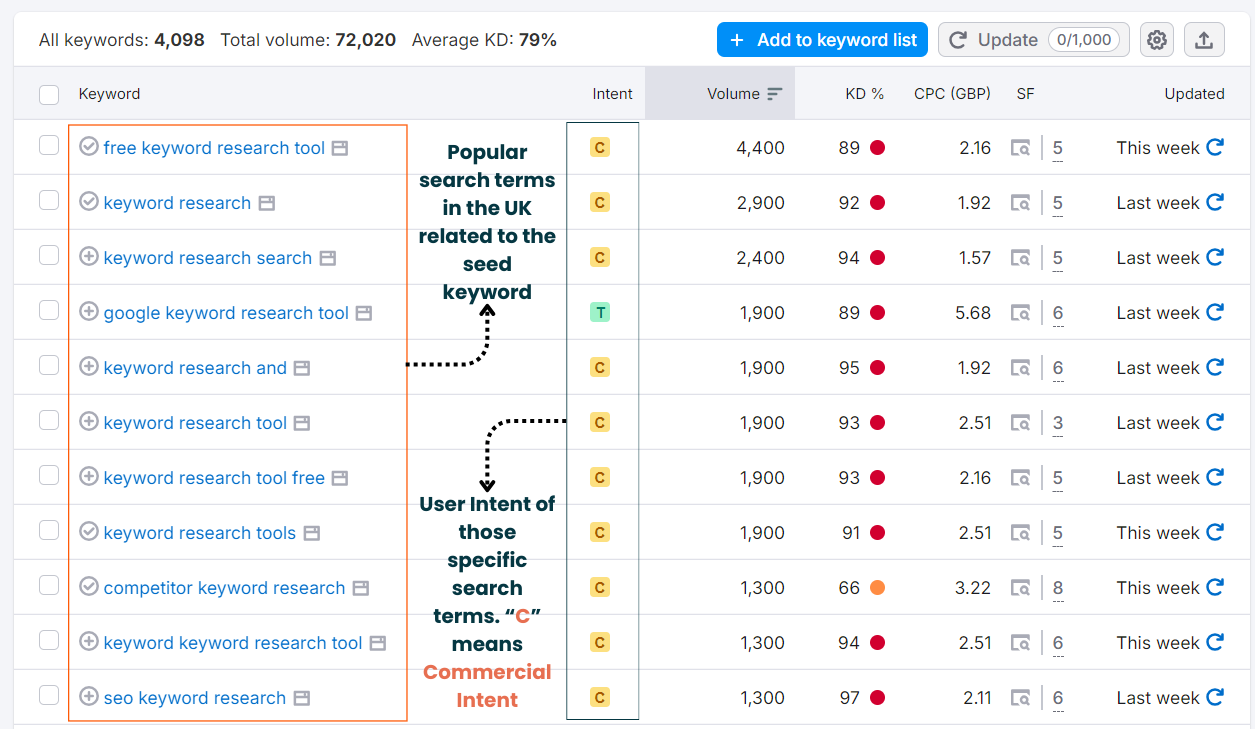
Keyword research is a fundamental aspect of SEO that involves identifying and analysing the specific keywords and search terms that people use when searching for information online. It is the process of understanding what language your target audience uses to express their needs, which allows businesses to create content that directly addresses those needs and improves search engine rankings.
There are several types of keywords that you’ll encounter during the keyword research process:
- Short tail keywords: These are broad search terms consisting of one or two words, such as “SEO” or “content marketing.” They tend to have high search volumes but are also highly competitive, making them essential for visibility but challenging to rank for.
- Long tail keywords: These are more specific phrases, usually three or more words long, like “how to do keyword research” or “best keyword research tools.” While they have lower search volumes, they often have higher conversion rates because they target more specific queries, making them crucial for targeting niche markets.
- LSI keywords: Latent Semantic Indexing (LSI) keywords are terms that are conceptually related to the main keyword. For example, if your primary keyword is “keyword research,” related LSI keywords might include “SEO strategy,” “search engine optimisation,” “content strategy,” and “search engine rankings.” Incorporating LSI keywords helps search engines understand the context of your content, which can improve your overall SEO strategy.
Understanding the different types of keywords and how to identify them is crucial for developing a successful SEO strategy. By conducting thorough keyword research and utilising tools like Google Keyword Planner, SEMrush, or Ahrefs, you can uncover valuable keyword opportunities that align with your business goals.
Unsure how keyword research can drive more traffic and conversions? Our team can provide tailored insights and strategies to help you achieve your business goals. Contact us for a free consultation
Why Is Keyword Research Important?
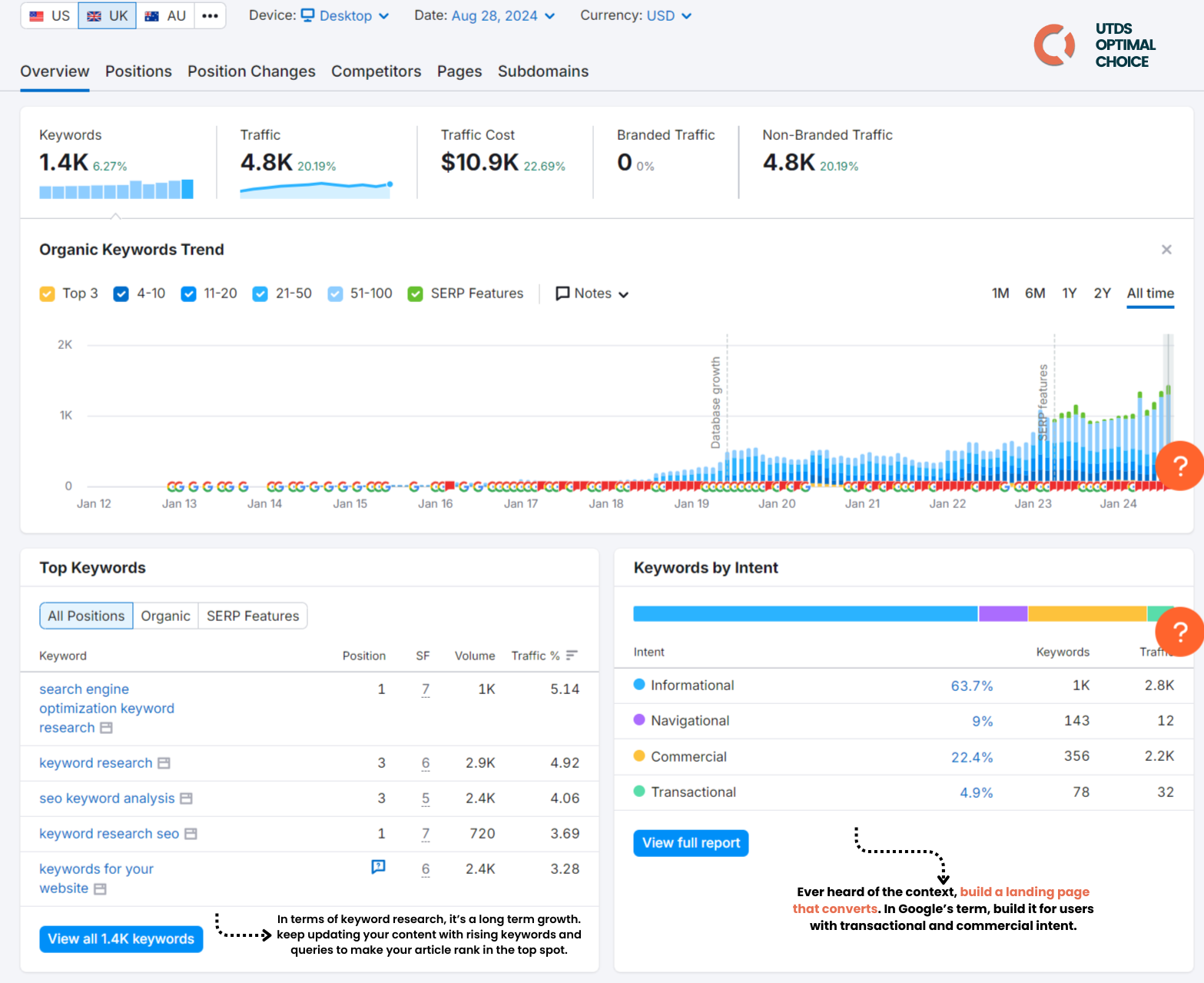
Keyword research is not just a foundational step in SEO; it is the cornerstone of a successful digital marketing strategy. Keyword research is crucial for businesses looking to improve their online visibility, attract the right audience, and maximise their return on investment (ROI).
Driving Organic Traffic:
- By identifying the keywords that your target audience is searching for, you can create content that is highly relevant to their needs. This relevance increases the chances of your content ranking higher in search engine results, thereby driving more organic traffic to your website. In fact, well researched SEO keywords can lead to sustained traffic growth over time, which is vital for long term success.
Understanding User Intent:
- Effective keyword research helps you understand the intent behind users searches. Whether they are looking for information (informational intent), trying to navigate to a specific site (navigational intent), or ready to make a purchase (transactional intent), knowing this intent allows you to tailor your content to meet their needs. Aligning your content with user intent not only improves engagement and conversion rates but also enhances the overall user experience on your website.
Optimising Content for SEO:
- Keywords are the building blocks of SEO. By strategically placing relevant keywords throughout your content, you can ensure that search engines recognise the topic and relevance of your page. This optimisation leads to better rankings, more visibility, and higher click through rates (CTR). Moreover, by integrating LSI keywords and semantic SEO techniques, you can further enhance your content’s relevance, making it more likely to rank for a variety of related search queries.
Competitive Advantage:
- Conducting thorough competitive keyword research also allows you to analyse your competitors strategies. By identifying which keywords they are targeting, you can find gaps in their strategy or opportunities to outperform them by targeting less competitive, high value keywords. This competitive analysis not only helps you differentiate your content but also ensures that you are capturing potential traffic that your competitors might be overlooking.
Maximising ROI:
- Investing time and resources into keyword research ensures that your content marketing efforts are focused on the right topics. This focus not only improves your search engine rankings but also maximises your return on investment (ROI) by driving more targeted traffic to your site. By targeting commercial intent keywords, you can attract users who are more likely to convert, thereby increasing your chances of turning visitors into customers.
- Investing time and resources into keyword research ensures that your content marketing efforts are focused on the right topics. This focus not only improves your search engine rankings but also maximises your return on investment (ROI) by driving more targeted traffic to your site. By targeting commercial intent keywords, you can attract users who are more likely to convert, thereby increasing your chances of turning visitors into customers.
In summary, keyword research is essential for creating content that resonates with your audience, improves SEO performance, and helps you stay competitive in the digital landscape. Without it, even the best written content may fail to reach its intended audience or achieve its intended business objectives.
Elements Of Keyword Research
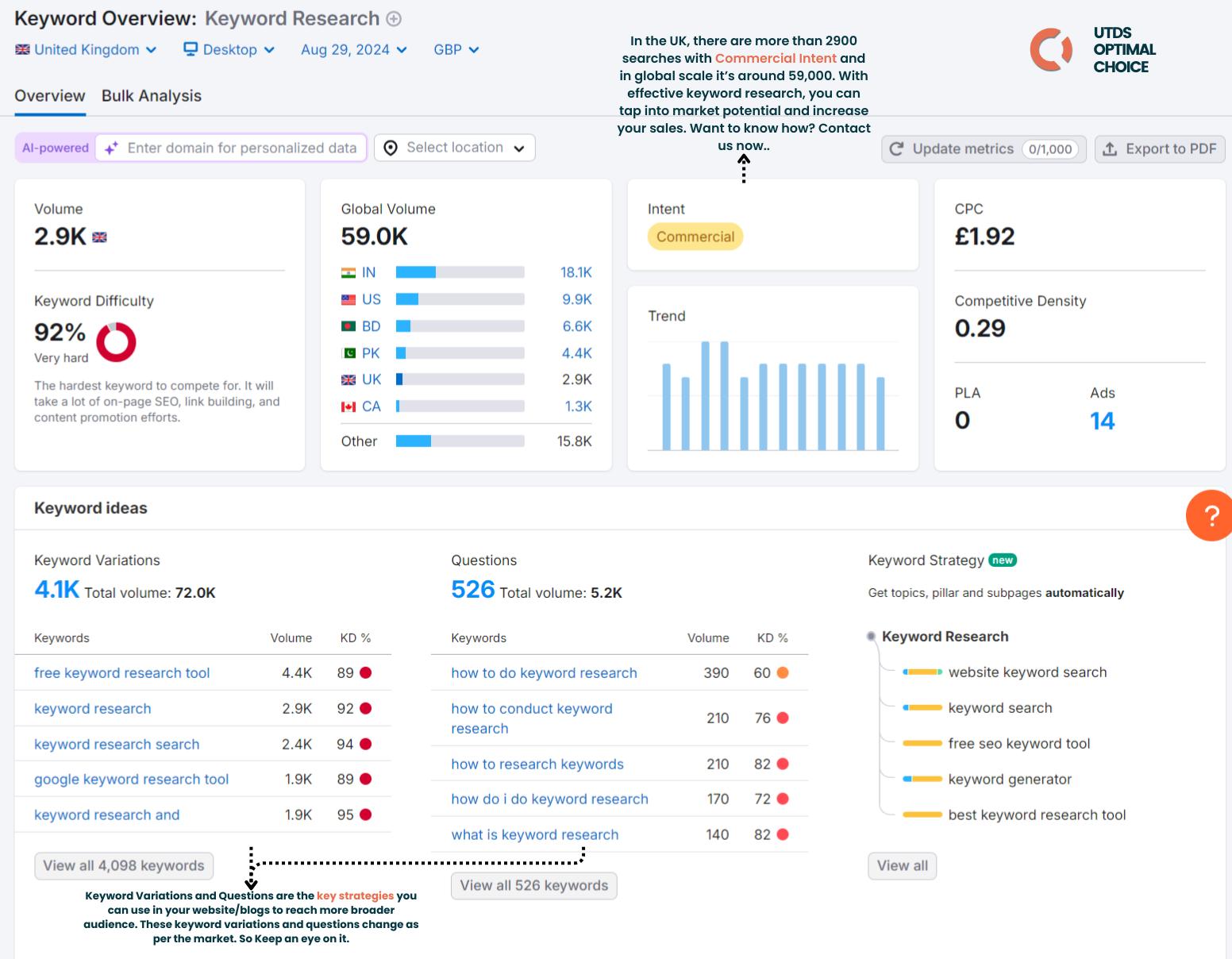
Understanding the key elements of keyword research is essential for developing an effective SEO strategy. These elements help you identify the most valuable keywords for your business, ensuring that your content is optimised for both search engines and your target audience. Let’s explore the core components of the keyword research process:
Search Volume:
- Search volume refers to the number of times a particular keyword is searched for within a given timeframe, usually measured monthly. High search volume indicates a popular keyword, but it often comes with high competition. Tools like Google Keyword Planner, SEMrush, and Ahrefs can help you determine the search volume for specific keywords. While it’s tempting to target only high volume keywords, balancing them with lower volume, high user intent long tail keywords can be more effective. Additionally, understanding the difference between global and local search volume can help you tailor your content to the right audience.
Keyword Difficulty:
- Keyword difficulty measures how challenging it will be to rank for a particular keyword. This metric considers the competition, including the strength and authority of the websites currently ranking for that keyword. Tools like Moz and SEMrush provide keyword difficulty scores, helping you prioritise keywords that offer the best balance between difficulty and potential ROI. Targeting a mix of high difficulty and low difficulty keywords can create a well rounded SEO strategy that balances quick wins with long term goals.
Relevance:
- Keyword relevance is about ensuring that the keywords you target are directly related to your business, products, or services. Even if a keyword has high search volume, it won’t be valuable if it doesn’t align with the intent of your target audience. Conducting thorough SEO keyword research allows you to identify the keywords that are not only popular but also relevant to your content and business goals. Tools like Google Search Console can help you assess which keywords are driving traffic to your site and whether they align with your content strategy.
Competition:
- Understanding the competitive landscape is crucial when selecting keywords. Analysing your competitors SEO strategies can reveal which keywords they are targeting and how well they are ranking for them. By identifying gaps in their keyword strategy, you can uncover opportunities to target high value keywords with less competition. Tools like Ahrefs Competitor Analysis and SEMrush Keyword Gap Analysis can provide insights into your competitors strengths and weaknesses, helping you refine your own strategy.
Trends and Seasonal Keywords:
- Some keywords may experience fluctuations in search volume due to trends or seasonality. For example, keywords like “Halloween costumes” spike in October, while “tax preparation” sees increased searches in the months leading up to tax deadlines. Using tools like Google Trends can help you identify these seasonal keywords and incorporate them into your content strategy at the right time. Additionally, monitoring industry trends can help you stay ahead of emerging keywords that could become valuable in the future.
Intent Alignment:
- Aligning keywords with user intent is perhaps the most critical element of keyword research. Whether users are looking for information (informational intent), comparing products (navigational intent), or ready to make a purchase (transactional intent), the keywords you target should match their intent. By understanding and targeting informational, navigational, and transactional keywords, you can create content that meets users needs at every stage of their journey. Additionally, using semantic SEO to understand the broader context of user queries can help you capture more related search traffic.
Ready to take your business to the next level? We offer tailored solutions to help you optimise your content and attract more organic traffic. Contact us now for free consultation.
How To Do Keyword Research?
How To Research Keywords For Your SEO Strategy
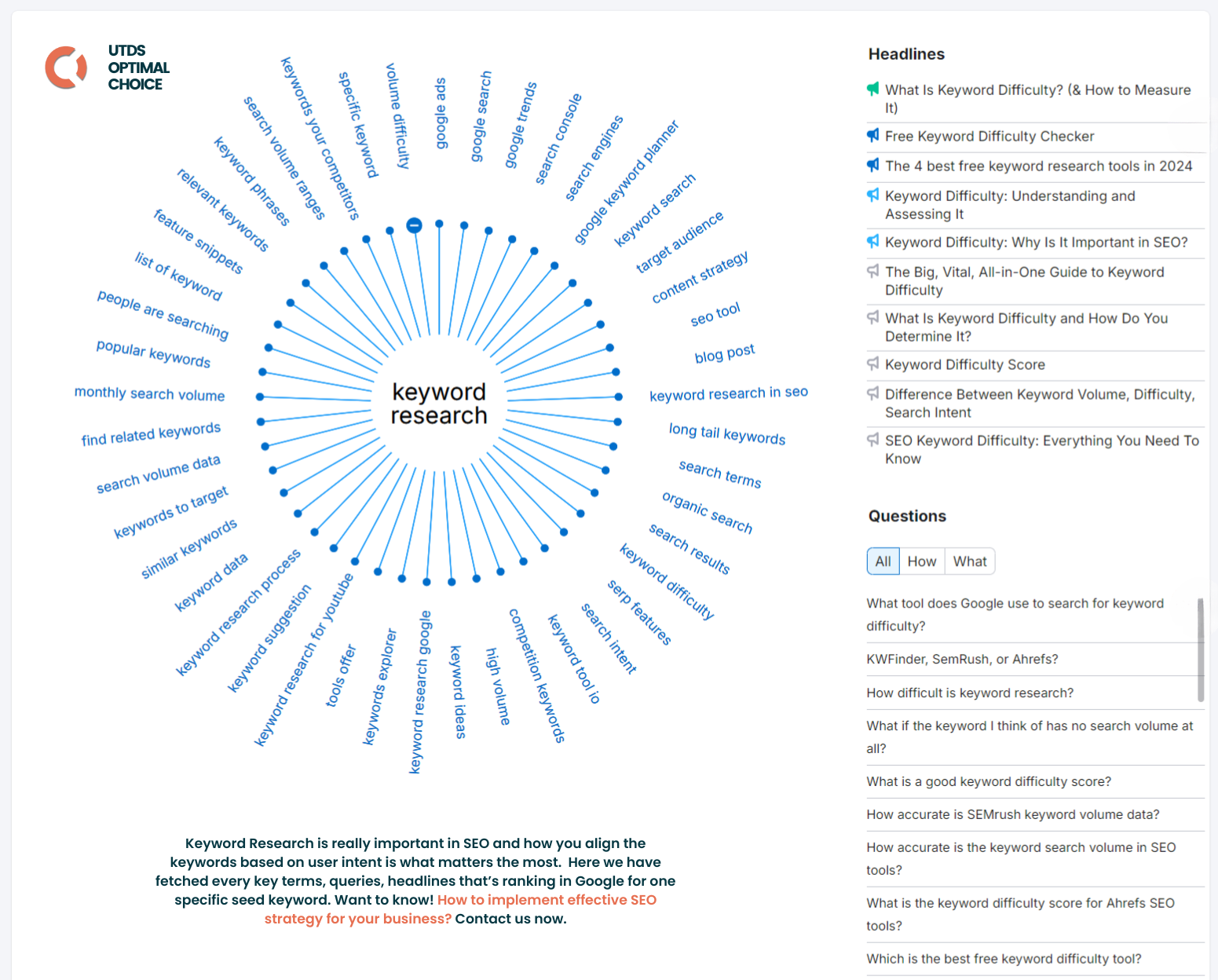
Researching keywords is a crucial part of developing a successful SEO strategy. By following a structured process, you can identify the most valuable keywords that align with your business goals and target audience. Here’s a step-by-step guide on how to conduct effective keyword research:
Start with Seed Keywords:
- Seed keywords are the foundation of your keyword research. These are the basic terms that are closely related to your business, products, or services. For example, if you run a digital marketing agency, seed keywords might include “SEO,” “content marketing,” or “PPC campaign management.” Begin by brainstorming a list of these core keywords that represent the main topics you want to rank for. Utilising tools like Google Keyword Planner can help you identify high potential seed keywords that serve as the base for further expansion.
Expand with Long Tail Keywords:
- Once you have your seed keywords, the next step is to expand them into more specific long tail keywords. Long tail keywords are longer phrases that often have lower search volumes but higher intent. For instance, from the seed keyword “SEO,” you might expand to “how to improve SEO for small business” or “best SEO practices for e-commerce.” Tools like SEMrush, Ahrefs, and Moz can help you generate long tail keywords that are relevant and valuable. Additionally, focusing on local long tail keywords can help you attract a more targeted local audience, especially if your business serves specific geographic areas.
Analyse Keyword Metrics:
- With a list of potential keywords in hand, the next step is to analyse key metrics such as search volume, keyword difficulty, and click through rate (CTR). High search volume indicates a popular keyword, but if the keyword difficulty is too high, it might be challenging to rank for. Balancing these metrics is crucial for identifying keywords that are both achievable and valuable. Tools like Google Keyword Planner and Moz offer insights into these metrics, helping you make informed decisions. Additionally, understanding keyword trends can help you capitalise on emerging search terms before they become highly competitive.
Understand User Intent:
- Effective keyword research goes beyond metrics; it’s also about understanding the user search intent behind each keyword. Are users looking for information, comparing options, or ready to make a purchase? Classify your keywords into categories based on user intent—informational, navigational intent, and transactional and ensure that your content aligns with what users are seeking at each stage of their journey. Incorporating semantic SEO techniques can help you better understand and target related search queries, enhancing your contents ability to meet user needs.
Conduct Competitor Analysis:
- Analysing your competitors keyword strategies can provide valuable insights and reveal opportunities. Use tools like Ahrefs or SEMrush to see which keywords your competitors are ranking for and where they may have gaps. By targeting keywords that your competitors are overlooking, you can carve out a niche and improve your own rankings. Additionally, using competitor keyword gap analysis can help you discover high value keywords that are underutilised in your industry, providing an edge in search rankings.
Prioritise and Organise Keywords:
- After gathering and analysing your keywords, prioritise them based on factors like relevance, search volume, and competition. Organise your keywords into groups or clusters that reflect the topics you plan to create content around. This approach, known as keyword clustering, allows you to create comprehensive content that targets multiple keywords within a single page, improving your chances of ranking for a broader range of search queries. Additionally, using topic clusters can enhance your content’s relevance and authority in the eyes of search engines.
Use Tools for Continuous Research:
- Keyword research is not a one-time task but an ongoing process. As search trends and user behaviour evolve, it’s important to continuously update your keyword strategy. Tools like Google Search Console, SEMrush, and Moz can help you monitor your rankings, discover new keywords, and adjust your strategy accordingly. Implementing a regular review process, such as quarterly or bi-annual keyword audits, can ensure that your SEO efforts remain aligned with current trends and continue to deliver results.
How To Find And Choose Keywords For Your Website
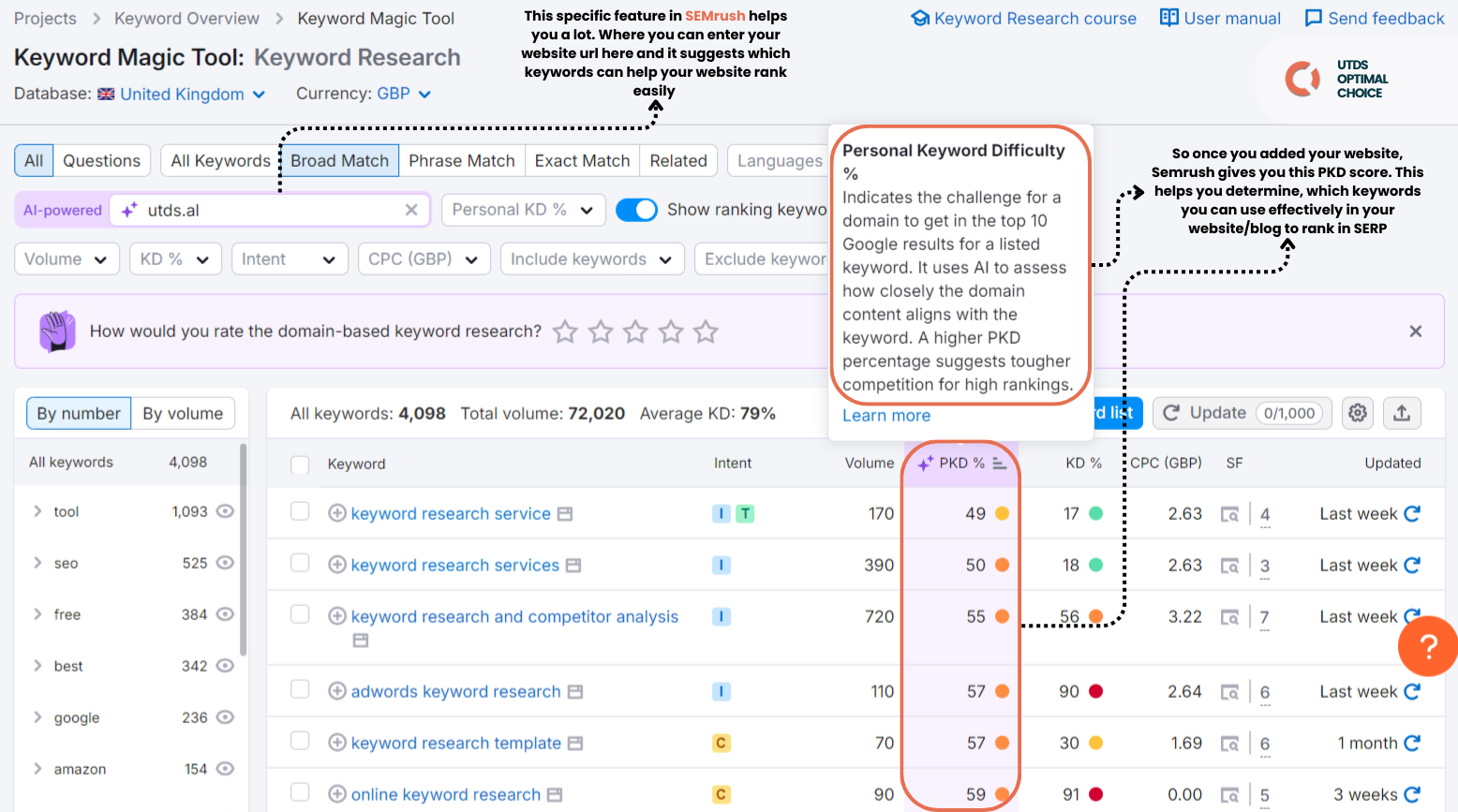
Choosing the right keywords for your website is crucial for attracting the right audience, improving your SEO performance, and driving meaningful conversions. By following a systematic approach, you can select keywords that align with your business objectives and resonate with your target audience. Here’s how to find and choose the most effective keywords for your website:
Identify Your Target Audience:
- Understanding your target audience is the first step in selecting the right keywords. Consider who your ideal customers are, what problems they are trying to solve, and how they might search for solutions. Creating detailed buyer personas can help you identify the specific keywords that your audience is likely to use. For example, if you’re targeting small business owners looking for digital marketing solutions, keywords like “best PPC Campaign Management services for small business” or “affordable SEO services for startups” might be relevant. Additionally, consider the demographics and geographic location of your audience, as these factors can influence the keywords they use.
Utilise Keyword Research Tools:
- Leverage tools like Google Keyword Planner, SEMrush, Ahrefs, and Moz to generate a list of potential keywords. These tools allow you to explore related keywords, assess their search volume, keyword difficulty, and competition. Additionally, tools like Google Trends can help you identify rising search terms and seasonal keywords that might be valuable. Focusing on both high volume and niche long tail keywords can help you balance your strategy between broad reach and specific targeting. Don’t forget to consider local keywords if your business operates in specific regions or serves a local audience.
Analyse Competitor Keywords:
- Conduct a competitor analysis to see which keywords your competitors are ranking for. Tools like Ahrefs and SEMrush can show you the top ranking keywords for competing websites, as well as where there might be gaps in their strategy. By identifying high value keywords that your competitors are targeting, and finding opportunities where you can differentiate yourself, you can create content that stands out and ranks better. Additionally, using competitor keyword gap analysis can reveal keyword opportunities that are underutilised in your industry, providing a competitive edge.
Prioritise High Intent Keywords:
- Not all keywords are created equal. High purchase intent keywords are those that indicate a user is close to making a decision or taking action are particularly valuable for driving conversions. Examples of high intent keywords include “buy,” “discount,” “free trial,” or “best.” Prioritise these transactional keywords in your strategy to capture users who are ready to convert. Additionally, focus on commercial intent keywords that are relevant to your products or services to attract a more targeted audience. Incorporating long tail keywords with high transactional intent can also help you capture niche markets with specific needs.
Consider Keyword Relevance:
- Ensure that the keywords you choose are highly relevant to the content on your website. Relevance is key to both ranking well in search engines and engaging your audience. If a keyword drives traffic to your site but doesn’t match the content or intent, it will lead to high bounce rates and poor user experience. Focus on keywords that align with your business goals and the needs of your audience. Tools like Google Search Console can help you track which keywords are driving traffic and whether they are relevant to your site’s content.
Use Keyword Clustering:
- Organise your keywords into clusters based on related topics or themes. Keyword clustering allows you to create comprehensive content that covers multiple related keywords within a single page. This approach not only improves your chances of ranking for a broader range of search queries but also enhances the user experience by providing in-depth information on a specific topic. Tools like SEMrush and Ahrefs can help you identify which keywords to cluster together based on their semantic relevance. Additionally, implementing topic clusters as part of your content strategy can help establish your website as an authority in your niche.
Monitor and Adjust Your Strategy:
- Keyword selection is not a set-it-and-forget-it process. Continuously monitor the performance of your chosen keywords using tools like Google Search Console, SEMrush, and Moz. Track metrics such as rankings, click-through rates (CTR), and conversion rates to assess the effectiveness of your keyword strategy. Be prepared to adjust your strategy as needed based on changing search trends, user behaviour, and industry developments. Regular keyword audits can help you stay ahead of the competition and ensure that your content remains relevant and optimised.
Don't miss out on the opportunity to boost your online visibility and drive more conversions. Our expert keyword research services can help you identify the most relevant keywords for your target audience and optimise your content for search engines. Contact us today to schedule a free consultation and learn how we can help you achieve your business goals.
Advanced Keyword Research Techniques
While foundational keyword research is crucial, advanced techniques can give you an edge in a competitive landscape. These techniques allow you to uncover hidden opportunities, optimise for emerging trends, and refine your SEO strategy to stay ahead of the competition. Here are some advanced keyword research techniques that can improve your SEO efforts:
Competitive Keyword Gap Analysis:
- Competitive keyword gap analysis involves identifying keywords that your competitors are ranking for but you are not. Tools like Ahrefs and SEMrush allow you to compare your site’s keyword profile with those of your competitors, revealing gaps in your content strategy. By targeting these untapped keywords, you can capture valuable traffic that your competitors might be overlooking. This technique is particularly effective for discovering long tail keywords and niche opportunities that can drive highly targeted traffic. Additionally, using competitive benchmarking can help you measure your performance against industry standards, ensuring your strategy remains competitive.
Topic Clustering and Content Silos:
- Topic clustering involves organising your content around key themes or topics, with a central “pillar” page that links to more detailed subtopics. This strategy not only helps with keyword clustering but also improves your site’s authority on specific subjects. Content silos take this a step further by creating a hierarchical structure within your website, where related content is grouped together to boost relevance. Implementing topic clusters and content silos can improve your site’s internal linking structure, enhance user experience, and increase your chances of ranking for a broader range of keywords. This approach also aids in content depth and keyword relevance, helping search engines better understand the context of your content.
Semantic SEO and Entity Optimisation:
- Semantic SEO focuses on understanding the context and meaning behind users search queries, rather than just matching exact keywords. This approach involves optimising your content to align with the intent behind the search, using related terms, synonyms, and entities that search engines recognise as being associated with your primary keywords. Entity optimisation is a related technique that involves optimising for specific people, places, brands, or concepts that are recognised as “entities” by search engines. By incorporating semantic SEO and entity optimisation, you can improve your contents relevance and visibility for a wider range of search queries. Additionally, utilising structured data can enhance how search engines interpret your content, potentially leading to better rankings and richer search results, like rich snippets.
Voice Search Optimisation:
- With the rise of voice activated devices like Siri, Alexa, and Google Assistant, voice search optimisation has become increasingly important. Voice searches tend to be longer and more conversational than text searches, often taking the form of questions. To optimise for voice search, focus on long tail keywords that mimic natural speech patterns and include question based keywords. Additionally, creating content that directly answers common questions in a concise and clear manner can help you capture featured snippets, which are often used as voice search responses. Ensuring your site is mobile friendly and loads quickly also supports voice search, as these factors are crucial for user experience in voice activated queries.
Use AI and Machine Learning in Keyword Research:
- Artificial Intelligence (AI) and machine learning technologies are transforming how keyword research is conducted. Tools like BrightEdge and MarketMuse use AI to analyse vast amounts of data and provide insights into keyword trends, content gaps, and optimisation opportunities. These tools can predict which keywords are likely to gain popularity in the future, allowing you to stay ahead of the curve. Additionally, AI-driven content optimisation tools can help you fine-tune your content to better match search engine algorithms, improving your chances of ranking higher. Incorporating natural language processing (NLP) techniques can also enhance your contents ability to align with how search engines interpret and rank text, especially with the increasing sophistication of algorithms like Googles BERT.
Monitoring and Adapting to Keyword Trends:
- Keyword trends can change rapidly due to shifts in user behaviour, technological advancements, and industry developments. Tools like Google Trends and BuzzSumo allow you to monitor these trends in real-time, helping you identify emerging keywords and adjust your SEO strategy accordingly. Staying agile and adapting to these changes is crucial for maintaining your site’s relevance and visibility. Regularly updating your content to reflect the latest trends and incorporating new keywords can ensure that your site remains competitive in search results. Additionally, using predictive analytics can help you anticipate future trends, allowing you to optimise your content ahead of the competition.
Common Mistakes To Avoid In Keyword Research
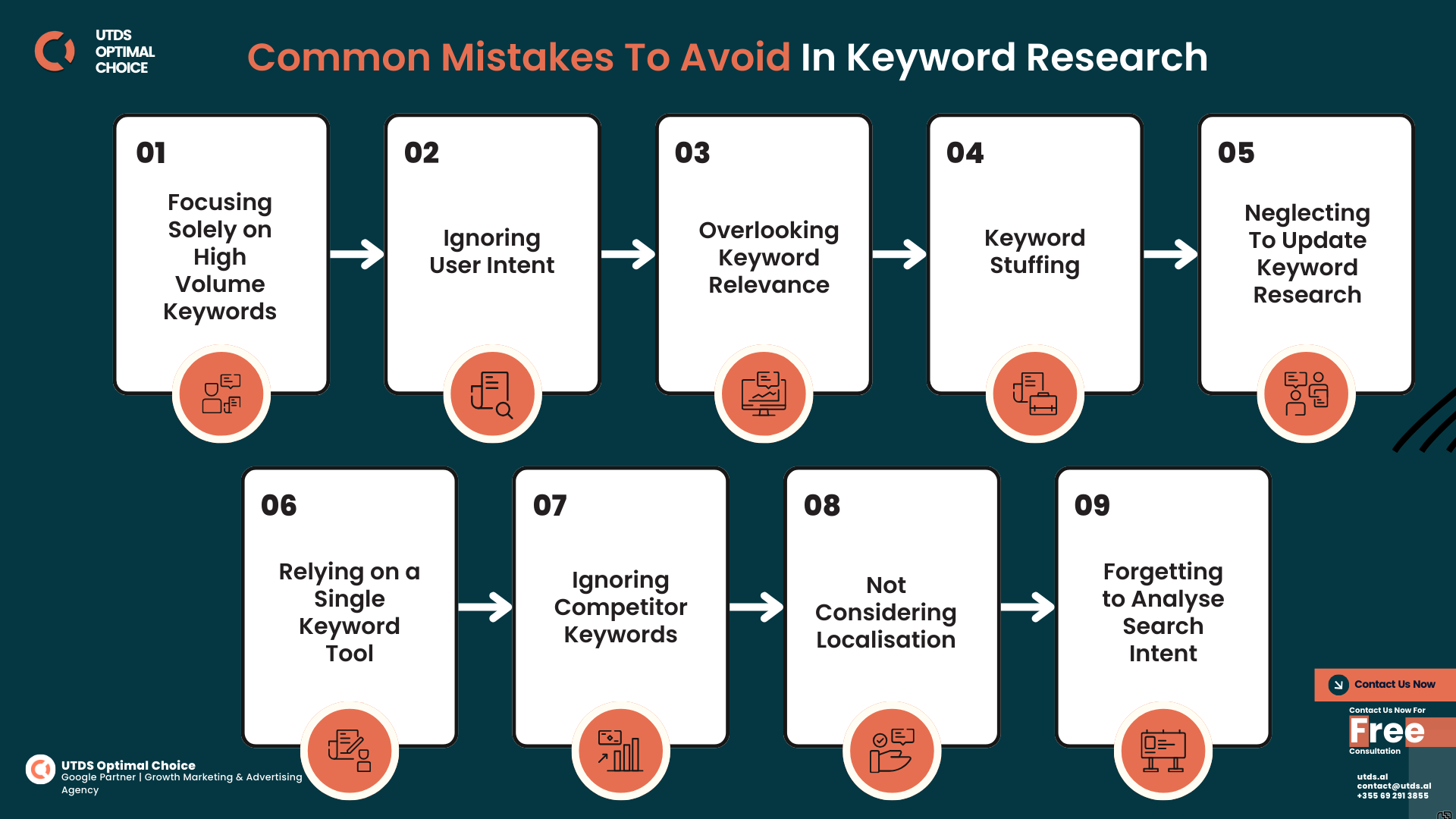
While keyword research is a critical part of any successful SEO strategy, it’s easy to make mistakes that can undermine your efforts. Avoiding these common pitfalls will help ensure that your keyword strategy is effective and aligned with best practices. Here are some common mistakes to avoid in keyword research:
Focusing Solely on High Volume Keywords:
- One of the most common mistakes is prioritising high volume keywords without considering their relevance, competition, or user search intent. While high search volume can drive more traffic, it often comes with high competition, making it difficult to rank. Moreover, high volume keywords may not always align with what your target audience is actually searching for. To avoid this mistake, balance your strategy with a mix of long tail keywords, high intent keywords, and low competition keywords that are more likely to convert.
Ignoring User Intent:
- Focusing solely on keywords without considering user intent can lead to poor content performance. User intent refers to the underlying goal a user has when they perform a search, whether they are looking for information, trying to make a purchase, or seeking a specific website. Ignoring user intent can result in content that doesn’t meet the needs of your audience, leading to high bounce rates and low engagement. Always categorise your keywords based on intent informational, navigational, or transactional and ensure your content aligns with these categories. Incorporating intent mapping into your SEO strategy can help you better align your content with user needs.
Overlooking Keyword Relevance:
- Targeting keywords that are not directly relevant to your content or business can drive traffic that doesn’t convert. Relevance is crucial for both user experience and search engine rankings. If users land on your site and don’t find what they’re looking for, they’re likely to leave quickly, which can negatively impact your SEO. Always prioritise keyword relevance to ensure that your content is directly aligned with the search queries of your target audience. Tools like Google Search Console can help you track which keywords are driving traffic and whether they are relevant to your sites content.
Keyword Stuffing:
- Overusing keywords in your content in an attempt to manipulate search rankings is not only ineffective but can also lead to penalties from search engines. Modern SEO algorithms are sophisticated enough to recognise unnatural keyword usage. Instead of stuffing, focus on natural keyword integration and use LSI keywords and synonyms to enhance your contents relevance without overdoing it. Aim for a keyword density that feels natural and supports the readability of your content. Additionally, consider using semantic SEO techniques to enhance your contents context and relevance.
Neglecting to Update Keyword Research:
- Search trends and user behaviour change over time, and keyword research should be an ongoing process. Neglecting to update your keyword strategy can result in missed opportunities and outdated content. Regularly revisiting and refreshing your keyword research ensures that your content remains relevant and competitive. Use tools like Google Search Console, SEMrush, and Ahrefs to track the performance of your keywords and adjust your strategy based on the latest data. Implementing keyword audits on a regular basis can help you stay ahead of the competition and adapt to changing trends.
Relying on a Single Keyword Tool:
- While tools like Google Keyword Planner or Ahrefs are invaluable for keyword research, relying solely on one tool can limit your insights. Different tools offer different data points and perspectives, and combining insights from multiple tools can give you a more comprehensive view of the keyword landscape. Utilise a mix of tools such as SEMrush, Moz, Ahrefs, and Google Trends to gather a broader range of data and refine your keyword strategy. This multi-tool approach can also help you identify emerging keyword trends and spot keyword opportunities that might be missed by a single tool.
Ignoring Competitor Keywords:
- Overlooking the keywords your competitors are ranking for can mean missing out on valuable opportunities. Competitor analysis helps you understand what’s working in your industry and where you can gain an advantage. Tools like SEMrush and Ahrefs allow you to analyse competitor keywords, discover gaps in their strategy, and identify high value keywords that you can target to outrank them. By understanding your competitors keyword strategies, you can refine your own approach and capture more market share.
Not Considering Localisation:
- If your business operates in specific regions or serves a local audience, ignoring local keywords can lead to missed opportunities. Local SEO is crucial for businesses that rely on customers from specific geographic areas. Incorporate geo targeted keywords into your strategy to capture local search traffic and improve your visibility in regional search results. Additionally, using tools like Google My Business can enhance your local presence by ensuring that your business information is accurate and optimised for local searches.
Forgetting to Analyse Search Intent:
- Search intent analysis is essential for understanding why users are searching for specific terms and how to align your content with their needs. Without proper analysis, you might target keywords that don’t match the Google search intent, leading to poor engagement and low conversion rates. Use tools like Google Analytics and Ahrefs to analyse how users interact with your content based on the keywords they use, and adjust your content to better meet their expectations.
Case Studies And Success Stories
In this section, we’ll explore real world examples of how we used effective keyword research and SEO strategies to help businesses in three different industries achieve significant results. These case studies demonstrate the power of targeted keywords and strategic content planning.
1. Plumbing and Electrician Company in London (Covering All Over the UK, Especially Birminghamshire, Buckinghamshire, Newcastle, Bristol)
Overview: This case study focuses on a Plumbing and Electrician Company based in London that serves customers across the UK, with particular coverage on regions like Birmingham, Buckinghamshire, Newcastle upon Tyne, and Bristol. The company faced intense competition in these areas, making it challenging to rank for high traffic keywords.
Challenges:
- High competition in densely populated and diverse areas.
- Difficulty in ranking for broad, high volume keywords like “plumber near me” or “local electricians.”
- Need to attract customers from specific regions, each with different search behaviours and preferences.
Keyword Strategy:
- We used long tail keyword strategy, targeting specific services in each region, such as “emergency plumber in Buckinghamshire” and “certified electrician in Newcastle.”
- Implemented local SEO tactics, focusing on geo-targeted keywords like “plumber near me in Bristol” and “electrician services in Birminghamshire.”
- Utilised semantic SEO to optimise content for related terms and synonyms, ensuring the content addressed various user intents, such as informational and transactional searches.
- Created location specific landing pages optimised for local keywords, such as “best plumber in Newcastle” and “reliable electrician in Buckinghamshire,” to increase regional visibility.
Results:
- Significant increase in organic traffic from targeted regions, with a 45% growth in web traffic from Birmingham and Buckinghamshire.
- Improved rankings for regional keywords, achieving first page positions for terms like “emergency plumber in Buckingham” and “electrician services in Newcastle.”
- Increased conversion rates by 30% due to the alignment of keywords with user intent, leading to more qualified leads.
- Enhanced brand visibility in highly competitive areas, positioning the company as a leading service provider in London and beyond.
2. Generator Company in Essex, Colchester
Overview: A Generator Company based in Essex, Colchester, sought to improve its online visibility and attract more local customers. The company offered a range of generator services, including sales, installation, and maintenance.
Challenges:
- Limited online presence and low visibility in local search results.
- Competition from larger national companies and local service providers.
- Need to educate potential customers about the different types of generators and their specific use cases.
Keyword Strategy:
- Focused on long tail keywords that matched specific customer queries, such as “diesel generator installation in Essex” and “generator maintenance services in Colchester.”
- Implemented content marketing strategies, creating informative blog posts and guides optimised for informational keywords like “how to choose the right generator” and “benefits of diesel generators.”
- Implemented local SEO tactics, optimising the website for geo-targeted keywords and ensuring accurate and consistent listings on platforms like Google My Business.
- Implemented on page optimisation by integrating LSI keywords and related phrases, such as “generator sales Essex” and “emergency generator services Colchester,” to capture a broader audience.
Results:
- A 60% increase in local search traffic within six months, with significant improvements in rankings for geo targeted keywords like “generator services in Essex” and “Colchester generator company.”
- Enhanced brand awareness and credibility through educational content, leading to a 25% increase in inquiries and consultations.
- Secured first page rankings for niche keywords, outpacing local competitors and establishing the company as a trusted provider in Essex and Colchester.
- Increased customer engagement and conversions through targeted content that addressed specific customer needs and queries.
3. Plumbing Company in Buckingham
Overview: A local Plumbing Company in Buckingham aimed to dominate the local market by improving its search engine rankings and driving more organic traffic from nearby areas.
Challenges:
- Limited brand recognition and online visibility in a competitive local market.
- Need to rank for both general plumbing services and emergency repair keywords.
- Desire to attract customers from neighbouring towns and villages.
Keyword Strategy:
- Focused on hyper local keywords such as “emergency plumber in Buckingham” and “water heater repair Buckingham.”
- Utilised content clustering techniques to create comprehensive guides and service pages that targeted multiple related keywords within a single piece of content, such as “plumbing maintenance tips for Buckingham homeowners.”
- Implemented structured data to enhance search engine understanding of the company’s services, leading to improved visibility in local search results.
- Developed a robust local SEO strategy, including optimising Google My Business profiles and gathering positive customer reviews to enhance local rankings.
Results:
- Achieved first page rankings for key local keywords, including “emergency plumber in Buckingham” and “plumbing services near me in Buckingham.”
- A 50% increase in organic traffic from Buckingham and neighbouring areas, resulting in a significant boost in inquiries and service bookings.
- Strengthened the company’s online reputation, with customer testimonials and reviews integrated into the content strategy, further improving local SEO performance.
- Improved customer retention and loyalty through content that provided ongoing value and addressed common plumbing issues.
These case studies illustrate the power of strategic keyword research and targeted SEO in driving measurable results across different industries and regions. By focusing on long tail keywords, local SEO, content optimisation, and customer centric content strategies, we helped these companies to improve their online visibility, attract more qualified leads, and achieve sustainable growth. Contact us now for free consultation.
Inspired by our success stories? Let's make yours the next one. Contact us today for a personalised consultation and discover how our expert keyword research services can grow your business.
Emerging Trends In Keyword Research
The field of keyword research is constantly evolving, driven by changes in user behaviour, advancements in technology, and updates to search engine algorithms. Staying ahead of these trends is crucial for maintaining a competitive edge in SEO. Here, we explore some of the most significant emerging trends in keyword research and how businesses can adapt to these changes.
1. Zero Click Searches and Featured Snippets
Overview: Zero click searches occur when users find the information they need directly on the search results page, often through featured snippets. As these searches become more common, optimising for featured snippets is increasingly important.
Strategies:
- Create concise, clear answers to common questions in your content to increase the likelihood of being featured in a snippet.
- Use headings and bullet points to structure your content in a way that makes it easy for search engines to extract relevant information.
- Optimise for question based keywords that are likely to trigger featured snippets, such as “How to maintain a generator in Essex?“
- Use tools like SEMrush to identify which of your content pieces are candidates for featured snippets and optimise them accordingly.
2. Mobile First Indexing
Overview: With Google’s shift to mobile first indexing, the mobile version of your website is now the primary version used for indexing and ranking. This trend underscores the importance of optimising your site for mobile users.
Strategies:
- Ensure your website is fully responsive, with a design that adapts to different screen sizes and devices.
- Optimise for mobile friendly keywords, considering that mobile users often use shorter, more direct queries.
- Improve page load speed and mobile usability, as these factors are critical for maintaining high rankings in a mobile first index.
- Regularly test your site’s mobile performance using tools like Google Mobile Friendly Test.
3. Visual and Video Search
Overview: Visual and video search are becoming increasingly important, particularly with the rise of platforms like YouTube and the use of visual recognition technologies. Optimising for these types of searches requires a different approach to keyword research.
Strategies:
- Optimise images with descriptive alt text and relevant keywords to improve visibility in visual search results.
- Leverage platforms like YouTube by optimising video titles, descriptions, and tags with keywords that reflect what users are searching for.
- Consider using structured data to enhance video content and increase its chances of appearing in search results.
- Monitor visual search trends using tools like Pinterest Trends and optimise accordingly.
4. Personalised Search and User Experience
Overview: Personalised search results are tailored to individual users based on their behaviour, location, and search history. As search engines continue to refine their personalisation algorithms, creating content that resonates with specific audiences is crucial.
Strategies:
- Use geo-targeted keywords and local content to cater to users in specific locations, enhancing their personalised search experience.
- Focus on user experience (UX) by creating intuitive, easy-to-navigate websites that keep users engaged.
- Implement personalisation strategies, such as dynamic content and personalised recommendations, to increase user engagement and satisfaction.
- Utilise analytics tools like Google Analytics to track user behaviour and refine your personalisation strategy.
5. Predictive SEO
Overview: Predictive SEO involves anticipating future trends and optimising content before the competition catches on. This proactive approach helps you stay ahead of the curve and capture search traffic for emerging topics.
Strategies:
- Use tools like Google Trends and BuzzSumo to identify emerging trends and keywords that are gaining traction.
- Create content around these emerging topics early, ensuring that you are one of the first to rank for these keywords.
- Continuously monitor industry news and updates to stay informed about potential changes that could impact search behaviour.
- Implement a content calendar that incorporates predictive SEO to ensure timely content publication.
Staying on top of these emerging trends in keyword research is essential for maintaining a competitive edge.
Why Choose UTDS Optimal Choice?
Navigating the complexities of PPC and SEO requires not only expertise but also a strategic approach tailored to your business goals. At UTDS Optimal Choice, we specialise in helping businesses like yours succeed in the digital landscape.
What We Offer:
- PPC Campaigns: Our expert team will create and manage your PPC campaigns to ensure maximum ROI. We target the right audience with the right message, driving high quality leads to your business.
- SEO Services: From keyword research to on page optimisation and link building, our best SEO services are designed to improve your rankings and increase organic traffic.
- Tailored Strategies: We don’t believe in one-size-fits-all solutions. Our strategies are customised to meet the unique needs of your business, ensuring that your SEO and PPC efforts are aligned with your overall marketing goals.
Ready to Take Your SEO and PPC to the Next Level? Contact Us Today!
If you’re ready to grow your online presence and achieve your business goals, UTDS Optimal Choice is here to help. Our team of experts is dedicated to delivering results driven PPC and SEO strategies that align with your vision.
Let’s work together to unlock the full potential of your digital marketing efforts. Reach out to us today to schedule a consultation and see how we can help your business grow.
Frequently Asked Questions (FAQs)
In this section, we address some of the most common questions related to keyword research and SEO. Whether you’re new to the concept or looking to refine your existing strategies, these FAQs will provide clear and concise answers to help you better understand the topic.
1. How Often Should I Update My Keyword Research?
Keyword research should be an ongoing process. Search trends and user behaviour can change over time, so it’s important to regularly update your keyword strategy. A good practice is to revisit your keyword research at least every quarter, or whenever you notice a significant change in your website’s traffic patterns. Use tools like Google Search Console and SEMrush to monitor keyword performance and adjust your strategy accordingly. Implementing regular keyword audits can help you stay ahead of the competition and ensure your content remains relevant.
2. What is the Difference Between Informational, Navigational, and Transactional Keywords?
Informational keywords are used by users looking for information or answers to specific questions (e.g., “how to fix a leaky faucet“). Navigational keywords are used when users want to find a specific website or brand (e.g., “Home Depot website“). Transactional keywords indicate a user’s intent to make a purchase or take a specific action (e.g., “buy a generator online“). Understanding the differences between these keyword types helps you tailor your content to meet different user intents, thereby improving engagement and conversion rates.
3. What Tools Are Best for Keyword Research?
Some of the best tools for keyword research include Google Keyword Planner, SEMrush, Ahrefs, Moz, and Google Trends. Each tool offers unique features, such as keyword suggestions, search volume data, competition analysis, and trend tracking. Using a combination of these tools can provide a comprehensive view of the keyword landscape and help you develop a robust SEO strategy. Additionally, tools like BuzzSumo and Ubersuggest can offer insights into content performance and emerging keyword trends.
4. How Do I Use Keywords Without Keyword Stuffing?
To use keywords effectively without keyword stuffing, focus on integrating them naturally into your content. Place keywords in strategic locations such as the title, headings, and first 100 words of your content. Use variations, synonyms, and LSI keywords to maintain relevance without overusing the same terms. Prioritise readability and ensure that your content provides value to the reader. Additionally, consider using semantic SEO to enhance content relevance and ensure it aligns with user intent.
5. What is Local SEO and How Can I Optimise for It?
Local SEO is the practice of optimising your website to attract traffic from local searches. To optimise for local SEO, focus on geo-targeted keywords that include your location (e.g., “plumber in Buckingham“). Ensure your business information is consistent across online directories, including your Google My Business profile. Encourage customer reviews and create locally focused content to improve your visibility in regional search results. Additionally, optimising your websites mobile experience is crucial for local searches, as many users search on mobile devices.







